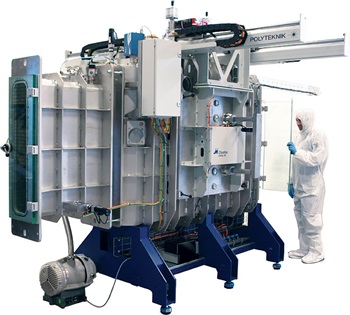Modern low-energy windows insulate so well that condensation can form on the outside.
DTU Energy, Velux and Polyteknik aim to solve the problem using advanced plasma technology.
By Anders Smith
Low-energy windows with three layers of glass can insulate so well that condensation forms on the outside under certain weather conditions. This problem can be overcome using a special coating on the outer glass, but this has required rare and expensive materials to date. DTU Energy has joined forces with the companies Polyteknik and Velux to develop a cheaper coating which can create a much larger market for condensation-free low-energy windows. The project, named SmartCoating, is receiving funding from Innovation Fund Denmark.
Condensation occurs when the air is cooled so much that the water vapour it contains forms water droplets. On poorly insulated windows, this is normally a problem on the inside surface. The inside pane is so cold that condensation forms when the moist indoor air comes into contact with it.
However, this problem rarely occurs with low-energy windows. These insulate so well that the temperature of the interior glass is close to the room temperature. But because of the good insulation properties, the outer layer of glass can conversely become so cold that the water vapour in the outside air condenses on it. This is the same phenomenon as when a vehicle windscreen is misty in the morning.
The problem can be relieved by depositing a thin electrically conductive layer on the outside of the glass. This helps prevent the glass from radiating its heat energy to its surroundings and thereby cooling down. Unfortunately, the material being used today—indium tin oxide (ITO)—is very expensive. Indium is a rare element, and there is great demand for ITO, which is also used in products like solar cells and touchscreens.
 |
|
The SmartCoating project aims to instead develop a coating using the much cheaper material AZO (aluminium zinc oxide). DTU Energy has demonstrated on a small scale that a film of this material can achieve the desired properties, but it is a challenge to develop a process that can apply a uniform coating to a large area such as a window pane. This will be a key element of the project.
“We’ve succeeded in bringing together a very strong team for the SmartCoating project: Polyteknik has in-depth knowledge of plasma depositing technologies on an industrial scale, perfectly complementing DTU Energy’s extensive insight into plasma processes and thin film characterization. The third partner, Velux, has advanced testing facilities and extensive knowledge of the window market. The project therefore covers all the necessary competences,” says Senior Researcher Eugen Stamate from DTU Energy, who is heading the project.
|